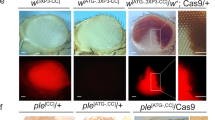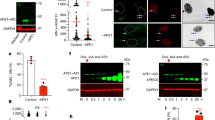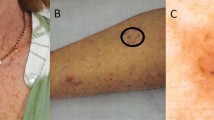Abstract
DEFECTS in human DNA repair proteins can give rise to the autosomal recessive disorders xeroderma pigmentosum (XP) and Cockayne's syndrome (CS), sometimes even together1–3. Seven XP and three CS complementation groups have been identified that are thought to be due to mutations in genes from the nucleotide excision repair pathway2,3. Here we isolate frog and human complementary DNAs that encode proteins resembling RAD2, a protein involved in this pathway in yeast4,5. Alignment of these three polypeptides, together with two other RAD2 related proteins6,7, reveals that their conserved sequences are largely confined to two regions. Expression of the human cDNA in vivo restores to normal the sensitivity to ultraviolet light and unscheduled DNA synthesis of lymphoblastoid cells from XP group G, but not CS group A. The XP-G correcting protein XPGC is generated from a messenger RNA of ∼4 kilobases that is present in normal amounts in the XP-G cell line.
This is a preview of subscription content, access via your institution
Access options
Subscribe to this journal
Receive 51 print issues and online access
$199.00 per year
only $3.90 per issue
Buy this article
- Purchase on Springer Link
- Instant access to full article PDF
Prices may be subject to local taxes which are calculated during checkout
Similar content being viewed by others
References
Cleaver, J. E. & Kraemer, K. H. in The Metabolic Basis of Inherited Disease 6th edn (eds Scriver, C. R., Beaudet, A. L., Sly, W. S. & Valle, D.) 2949–2971 (McGraw-Hill, New York, 1989).
Bootsma, D. & Hoeijmakers, J. H. J. Ann. Génét. 34, 143–150 (1991).
Lehmann, A. R. Cancer Rev. 7, 82–103 (1987).
Nicolet, C. M., Chenevert, J. M. & Friedberg, E. C. Gene 36, 225–234 (1985).
Madura, K. & Prakash, S. J. Bact. 166, 914–923 (1986).
Carr, A. M. et al. Nucleic Acids Res. 21, 1345–1349 (1993).
Jacquier, A., Legrain, P. & Dujon, B. Yeast 8, 121–132 (1992).
Gottlieb, E. & Steitz, J. A. EMBO J. 8, 851–861 (1989).
Scherly, D., Stutz, F., Lin-Marq, N. & Clarkson, S. G. J. molec. Biol. (in the press).
Tanaka, K. et al. Nature 348, 73–76 (1990).
Bankmann, M., Prakash, L. & Prakash, S. Nature 355, 555–558 (1992).
Hananian, J. & Cleaver, J. E. Clin. Genet. 17, 39–45 (1980).
Xu, S. & Schildkraut, I. J. biol. Chem. 266, 4425–4429 (1991).
Lin, J.-J., Phillips, A. M., Hearst, J. E. & Sancar, A. J. biol. Chem. 267, 17693–17700 (1992).
Morikawa, K. Curr. Opin. struct. Biol. 3, 17–23 (1993).
Dingwall, C. & Laskey, R. A. Trends biochem. Sci. 16, 478–481 (1991).
Weeda, G. et al. Cell 62, 777–791 (1990).
Legerski, R. & Peterson, C. Nature 359, 70–73 (1992).
Weber, C. A., Salazar, E. P., Stewart, S. A. & Thompson, L. H. EMBO J. 9, 1437–1447 (1990).
Flejter, W. L., McDaniel, L. D., Johns, D., Friedberg, E. C. & Schultz, R. A. Proc. natn. Acad. Sci. U.S.A. 89, 261–265 (1992).
Troelstra, C. et al. Cell 71, 939–953 (1992).
Spickofsky, N., Canfield, V. & Margolskee, R. F. DNA Prot. Engng Tech. 2, 14–18 (1990).
O'Donovan, A. & Wood, R. D. Nature 363, 185–188 (1993).
Robbins, J. H. Hum. Genet. 88, 242–242 (1991).
Kao, C. C. et al. Science 248, 1646–1650 (1990).
Cleaver, J. E. & Thomas, G. H. in DNA Repair. A Laboratory Manual of Research Procedures (eds Friedberg, E. C. & Hanawalt, P. C.) 277–287 (Dekker, New York, 1981).
Baitoch, A. & Boeckmann, B. Nucleic Acids Res. 19, 2247–2249 (1991).
Altschul, S. F., Gish, W., Miller, W., Myers, E. W. & Lipman, D. J. J. molec. Biol. 215, 403–410 (1990).
Bairoch, A. Nucleic Acids Res. 20, 2013–2018 (1992).
Leeder, J. S., Dosch, H.-M., Harper, P. A., Lam, P. & Spielberg, S. P. Analyt. Biochem. 177, 364–372 (1989).
Author information
Authors and Affiliations
Rights and permissions
About this article
Cite this article
Scherly, D., Nouspikel, T., Corlet, J. et al. Complementation of the DNA repair defect in xeroderma pigmentosum group G cells by a human cDNA related to yeast RAD2. Nature 363, 182–185 (1993). https://doi.org/10.1038/363182a0
Received:
Accepted:
Issue Date:
DOI: https://doi.org/10.1038/363182a0
This article is cited by
-
XPG genetic polymorphisms and clinical outcome of patients with advanced non-small cell lung cancer under platinum-based treatment: a meta-analysis of 12 studies
Cancer Chemotherapy and Pharmacology (2017)
-
Current evidences on the XPG Asp1104His polymorphism and melanoma susceptibility: a meta-analysis based on case–control studies
Molecular Genetics and Genomics (2015)
-
Quantitative assessment of the association between XPG Asp1104His polymorphism and bladder cancer risk
Tumor Biology (2014)
-
Polymorphisms in the XPG gene and risk of gastric cancer in Chinese populations
Human Genetics (2012)
-
The crystal structure of flap endonuclease-1 from Methanococcus jannaschii
Nature Structural & Molecular Biology (1998)
Comments
By submitting a comment you agree to abide by our Terms and Community Guidelines. If you find something abusive or that does not comply with our terms or guidelines please flag it as inappropriate.



